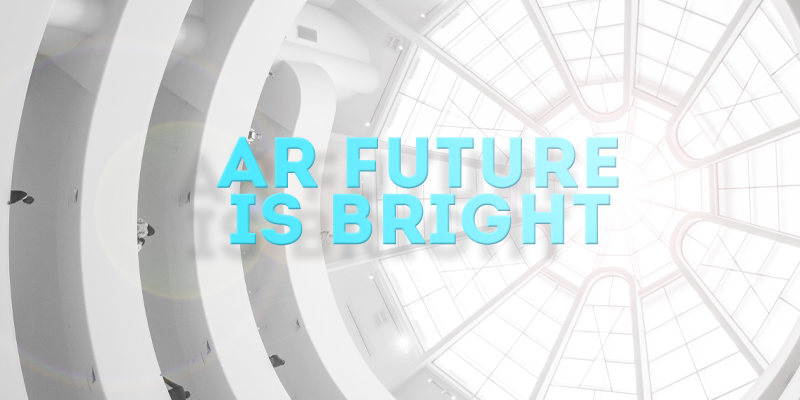As we enter the third quarter of 2016, the future of augmented reality has become very clear, and very bright. AR is a fast-growing field, with perhaps even more potential financial prospects than VR, although there is still some debate on the issue. Conflating this is the continued insistence by the press on confusing the two terms.
Unlike virtual reality, augmented reality applications can be effective both with the use of a head-mounted display (often known as smart glasses), or with just the use of a smartphone. This is known as mobile-based augmented reality, and that is the type of AR that is currently booming thanks to its accessibility and low barrier to entry. According to the analysts at Research and Markets, mobile-based augmented reality is expected to become a $79.77 billion market by 2022.
Hardware-driven AR, which uses a head-mounted display like VR, is quickly growing as well. Analysts at Digi-Capital report that Q3 2015 – Q3 2016 investments into AR and VR exceeded $2.3 billion dollars, with AR hardware forming a large piece of the pie.
What to Expect from Augmented Reality
In other words, the market is ready to swing hard towards augmented reality. The technology is on a quick rise thanks to the success of Pokémon GO and other popular apps. The public is hungry for more and more AR experiences. The wonderful accessibility of AR, which most often requires no dedicated hardware beyond an ordinary smartphone, is not lost on consumers or the press.
Many would argue that AR is more useful, as well. Unlike virtual reality, which immerses the user completely, AR can help guide the user through real life. VR has scores of applications in specialized fields, but it is unlikely to ever be as critical to day-to-day activities as AR.
All of this means that there are some truly amazing things on the horizon for both enthusiasts and professionals in the AR field. Our augmented reality future is at hand, and for our part, we are more than ready. From gaming to business to research, we may be entering a golden age for this technology.
Augmented Reality Gaming
One of the most exciting developments in augmented reality is the rise of true AR games. Pokémon GO blazed the trail for entertainment that blends the physical world with the digital. Although the number of trainers hunting for Squirtles has drastically fallen, at its peak the game enjoyed over 25 million players per day.
Those players are all looking for the next big thing, and developers and investors are more than happy to oblige. This is how these trends usually go in the gaming industry. Successful games are endlessly emulated and iterated upon as other studios race to carve out their slice of the pie.
Businesses realizing the potential of AR apps want custom yet affordable jobs done. Countless factors affect and alter the augmented reality application cost.
The wheels are already turning in all corners of the gaming industry. Press outlets ranging from The Guardian to Gamasutra, which focuses on the business and technology side of video games, have taken to publishing articles that basically amount to lists of ideas for augmented reality games.
To date, not many AR games have been released since Niantic’s short-lived behemoth, but it’s obvious that the public is hungry for more of a good thing. Pokémon GO was the tiniest tip of the iceberg. AR games are a brand-new genre, and the direction it goes is up to the developers, the publishers, and the investors who fuel them.
Snapchat Becomes Snap, Inc. and Approaches AR
Meanwhile, one of the biggest players in the social media space is positioning itself at the very core of augmented reality’s future scope. Snap, Inc., formerly Snapchat, has fired their first shot into the wearables market, and AR cannot be far behind.
Although the company is secretive, bits and pieces of their plans have escaped. In March, CNET reported that the $16 billion startup had begun quietly hiring hardware specialists, particularly employees with experience in the wearables field.
Perhaps most telling is Snapchat’s acquisition of Vergence Labs in 2014. Vergence came and went so quickly before their acquisition that many people don’t remember their chief product: a dedicated set of augmented reality glasses very similar to Google Glass.
Snap, Inc. dipped their toe into these waters with the release of Spectacles. It should be noted that the camera-equipped glasses are distinctly not augmented reality equipment. The device is a wearable camera, enabling users to easily broadcast their point of view out to their Snapchat followers.
At the same time, though, it’s not difficult to imagine the newly christened company developing Spectacles out further into a true AR device if it is successful. If Snap, Inc. does release an AR headset, the implications are massive. This year, the Snapchat service surpassed both Twitter and Pinterest in daily users, and hundreds of millions of users worldwide rely on it for their regular communications.
With such an immense user base, Snapchat is also becoming an increasingly critical piece of modern digital marketing. The service’s largest demographic is the always treasured 18-24. Not so coincidentally, the younger demographics are also traditionally the most receptive to new technologies.
If executed well, an AR solution from Snap, Inc. could spur more developments in augmented reality future applications than nearly any other company. They represent a perfect storm of market reach, financial resources, and technological savvy. Nothing is certain in the world of tech, but it’s entirely possible that Snapchat AR headsets will be almost as common in the future as smartphones are today.
The Burgeoning AR Hardware Market
Snap, Inc. is at the large corporate end of the augmented reality spectrum, but any meaningful movement in tech developments takes small innovators as well. Much has been written about the bevy of startups and creatives working in the space, and new AR-enabled mobile applications are released every week on both Apple and Android.
The astonishingly broad range of augmented reality apps include tattoo visualization, HUDs for aircraft, and high-tech navigation to the latest hot club or brunch café. The fact that AR is finding a foothold in so many areas points to its accessibility and acceptance by the public.
New AR hardware is fast approaching, as well. Giants like Microsoft and Google have been working on their offerings for years, but they are far from the only ones. Epson’s Moverio line is slowly but surely gaining traction in the business world.
Perhaps most important are startup firms like MetaVision and CastAR. These young companies are completely focused on bringing their dedicated augmented reality/mixed reality headsets to market, and they are giving the largest organizations a run for their money. Historically speaking, startups are often quicker, more agile, and more innovative than multi-billion dollar public companies.
How AppReal-VR Can Help?
The sheer number of opportunities in AR means that more developers than ever before are flocking to the augmented reality arena. There is an immense amount of bright young talent in the field. The key to success, though, is in finding a firm that combines talent and drive with experience and execution.
AppReal-VR is the pre-eminent Augmented Reality developer in Israel. The firm is led by CEO Yariv Levski, who has more than a decade of tech experience in a wide range of industries. Under his leadership, AppReal-VR delivers expertise in every stage of software development, from market analysis and preliminary white boarding to final deployment and post-release support.
To date, the company maintains relationships with satisfied clients in tourism, healthcare, marketing, fashion, and more. Using an agile development methodology, AppReal-VR keeps clients “in the loop” at every stage of development.
Augmented reality applications are executable and usable through the entire process, ensuring that both the developers and clients alike maintain a full awareness of the app’s progress and direction.
As well as AR, AppReal-VR is expert in virtual reality development and traditional mobile applications. The company is ideally suited to serve as a outsourcing partner to clients anywhere in the world, no matter their needs, size, or stage of growth.



In today’s world we can see that there are a lots of skeptics when it comes to technology and its achievements till today, but in the recent years we have seen a various tech innovations that will guide the people throw their years of living. At first there were the skeptics about smartphones, and later it proves that we actually can’t live without them and almost every single person on Earth use smartphone, and with that use - augmented reality can be accepted by many people and will become an irreplaceable part of their lives because it will help them with everything they want to see or feel…